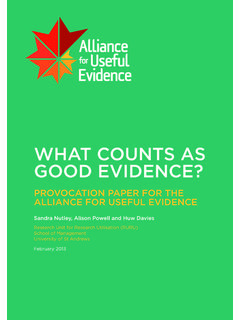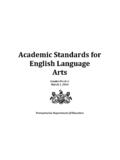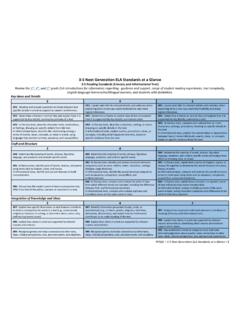Transcription of READING LITERARY (RL) READING ... - Georgia Standards
1 8th Grade English Language Arts Georgia Standards of excellence (ELA GSE) Georgia Department of Education Richard Woods, State School Superintendent March 2, 2015 Page 1 of 5 All Rights Reserved READING LITERARY (RL) READING INFORMATIONAL (RI) Key Ideas and Details Key Ideas and Details ELAGSE8RL1: Cite the textual evidence that most strongly supports an analysis of what the text says explicitly as well as inferences drawn from the text. ELAGSE8RI1: Cite the textual evidence that most strongly supports an analysis of what the text says explicitly as well as inferences drawn from the text. ELAGSE8RL2: Determine a theme and/or central idea of a text and analyze its development over the course of the text, including its relationship to the characters, setting, and plot; provide an objective summary of the text. ELAGSE8RI2: Determine a central idea of a text and analyze its development over the course of the text, including its relationship to supporting ideas; provide an objective summary of the text.
2 ELAGSE8RL3: Analyze how particular lines of dialogue or incidents in a story or drama propel the action, reveal aspects of a character, or provoke a decision. ELAGSE8RI3: Analyze how a text makes connections among and distinctions between individuals, ideas, or events ( , through comparisons, analogies, or categories). Craft and Structure Craft and Structure ELAGSE8RL4: Determine the meaning of words and phrases as they are used in a text, including figurative and connotative meanings; analyze the impact of specific word choices on meaning and tone, including analogies or allusi ons to other texts. ELAGSE8RI4: Determine the meaning of words and phrases as they are used in a text, including figurative, connotative, and technical meanings; analyze the impact of specific word choices on meaning and tone, including analogies or ELAGSE8RL5: Compare and contrast the structure of two or more texts and analyze how the diff ering structure of each text contributes to its meaning and style.
3 ELAGSE8RI5: Analyze in detail the structure of a specific paragraph in a text, including the role of particular se ntences in developing and refining a key concept. ELAGSE8RL6: Analyze how differences in the points of view of characters and the audience or reader ( , created through the use of dramatic irony) create such effects as suspense or humor. ELAGSE8RI6: Determine an author s point of view or purpose in a text and analyze how the author acknowledges and responds to confli cting evidence or viewpoints. Integration of Knowledge and Ideas Integration of Knowledge and Ideas ELAGSE8RL7: Analyze the extent to which a filmed or live production of a story or drama stays faithful to or departs from the text or script, evaluating the choices made by the director or actors. ELAGSE8RI7: Evaluate the advantages and disadvantages of using different mediums ( , print or di gital text, video, multimedia) to present a particular topic or idea.
4 ELAGSE8RL8: (Not applicable to literature) ELAGSE8RI8: Delineate and evaluate the argument and specific claims in a text, assessing whether the reasoning is sound and the evidence is relevant and sufficient; recognize when irrelevant evidence is introduced. ELAGSE8RL9: Analyze how a modern work of fiction draws on themes, patterns of events, or character types from myths, traditional stories, or religious works ELAGSE8RI9: Analyze a case in which two or more texts provide confli cting information on the sa me topic and identify where the texts disagree on Range of READING and Level of Text Complexity Range of READING and Level of Text Complexity ELAGSE8RL10: By the end of the year, read and comprehend literature, including stories, dramas, and poems, at the hi gh end of grades 6-8 text complexity band independently and proficiently ELAGSE8RI10: By the end of the year, read and comprehend LITERARY nonfiction at the high end of the grades 6-8 text complexity band independently and proficiently.
5 8th Grade English Language Arts Georgia Standards of excellence (ELA GSE) Georgia Department of Education Richard Woods, State School Superintendent March 2, 2015 Page 2 of 5 All Rights Reserved Text Types and Purposes ELAGSE8W1: Write arguments to support claims with clear reasons and relevant evidence. WRITING (W) a. Introduce claim(s), acknowledge and distinguish the claim(s) from alternate or opposing claims, and organize the reasons and evidence logically. b. Support claim(s) with logical reasoning and relevant evidence, using accurate, credible sources and demonstrating an understanding of the topic or text. c. Use words, phrases, and clauses to create cohesion and clarify the rela tionships among claim(s), counterclaims, reasons, and evidence. d. Establi sh and maintain a formal style . e. Provi de a concluding statement or section that foll ows from and supports the argument presented. ELAGSE8W2: Write informative/expla natory texts to examine a topic and convey ideas, concepts, and information through the selection, organization, and analysis of relevant content.
6 A. Introduce a topic clearly, previewing what is to foll ow; organize ideas, concepts, and information into broader categories; include formatting ( , headings), graphics ( , charts, tables), and mult imedia when useful to aiding comprehension. b. Develop the topic with relevant, well-chosen facts, definit ions, concrete detail s, quotations, or other in formation and examples. c. Use appropriate and varie d transit ions to create cohesion and clarify the relationships among ideas and concepts. d. Use precise la nguage and domain-specific vocabulary to inform about or explain the topic. e. Establi sh and maintain a formal style . f. Provi de a concluding statement or section that foll ows from and supports the information or explanation presented. ELAGSE8W3: Write narratives to develop real or imagined experiences or events using effective technique, relevant descriptive details, and well-structured event sequences.
7 A. Engage and orient the reader by establishing a context and point of view and introducing a narrator and/or characters; organize an event sequence that unfolds naturally and logically. b. Use narrative techniques, such as dialogue, pacing, description, and reflection, to develop experiences, events, and/or characters. c. Use a varie ty of transition words, phrases, and clauses to convey sequence, signal shifts from one time frame or settin g to another, and show the relationships among experiences and events. d. Use precise words and phrases, relevant descriptive details, and sensory language to capture the action and convey experiences and events. e. Provi de a conclusion that foll ows from and reflects on the narrated experiences or events. Producti on and Di stribution of Writing ELAGSE8W4: Produce clear and coherent writing in which the development, organization, and style are appropriate to task, purpose, and audience.
8 (Grade-specific expectations for writing types are defined in Standards 1 3 above.) ELAGSE8W5: With some guidance and support from peers and adults, develop and strengthen writing as needed by pla nning, revising, edit ing, rewriting, or tryin g a new approach, focusing on how well purpose and audience have been addressed. (Edit ing for conventions should demonstrate command of Language Standards 1 3 up to and including grade 8.) ELAGSE8W6: Use technology, including the Internet, to produce and publi sh writing and present the relationships between information and ideas efficiently as well as to interact and collaborate with others. Research to Bui ld and Present Knowledge ELAGSE8W7: Conduct short research projects to answer a question (including a self-generated question), drawing on several sources and generating addit ional r ela ted, focused questions that allow for mult ip le avenues of exploration. ELAGSE8W8: Gather relevant information from multip le print and digital sources, using search terms effectively; assess the credibility and accuracy of each source; and quote or paraphrase the data and conclusions of others while avoiding plagiarism and foll owing a standard format for citation.
9 ELAGSE8W9: Draw evi dence from LITERARY or in formational texts to support analysis, r eflection, and research. a. Apply grade 8 READING Standards to literature ( , Analyze how a modern work of fiction draws on themes, patterns of events, or character types from myths, t raditi onal stories, or religious works such as the Bib le, i ncluding describing how the material is rendered new ). b. Apply grade 8 READING Standards to LITERARY nonfiction ( , Delineate and evaluate the argument and specific claims in a text, assessin g whether the reasoning is sound and the evi dence is relevant and suffi cie nt; recognize when irrele vant evi dence is in troduced ). Range of Writing ELAGSE8W10: Write routinely over extended time frames (time for research, reflection, and revi sion) and shorter time frames (a single sit ting or a day or two) for a range of dis cipline-specific tasks, purposes, and audiences. 8th Grade English Language Arts Georgia Standards of excellence (ELA GSE) Georgia Department of Education Richard Woods, State School Superintendent March 2, 2015 Page 3 of 5 All Rights Reserved Comprehension and Collaboration SPEAKING AND LISTENING (SL) ELAGSE8SL1: Engage effectively in a range of collaborative discussions (one-on-one, in groups, and teacher-led) with diverse partners on grade 8 topics and texts, building on others ideas and expressing their own clearly.
10 A. Come to discussions prepared, having read or researched material under study; explicitly draw on that preparation by referring to evidence on the topic, text, or issue to probe and reflect on ideas under discussion. b. Follow rules for collegial discussions and decision-making, track progress toward specific goals and deadlines, and define individual roles as needed. c. Pose questions that connect the ideas of several speakers and elicit elaboration and respond to others questions and comments with relevant evidence, observations, and ideas. d. Acknowledge new information expressed by others, and, when warranted, qualify or justify their own views and understanding in light of the evidence presented. ELAGSE8SL2: Analyze the purpose of information presented in diverse media and formats ( , visually, quantitatively, orally) and evaluate the motives ( , social, commercial, political) behind its presentation. ELAGSE8SL3: Delineate a speaker s argument and specific claims, evaluating the soundness of the reasoning and relevance and sufficiency of the evidence and identifying when irrelevant evidence is introduced.














